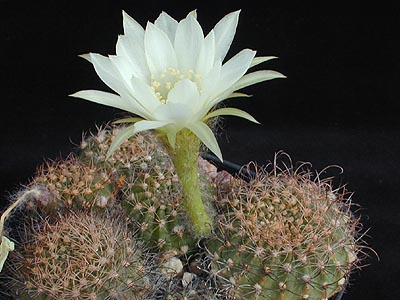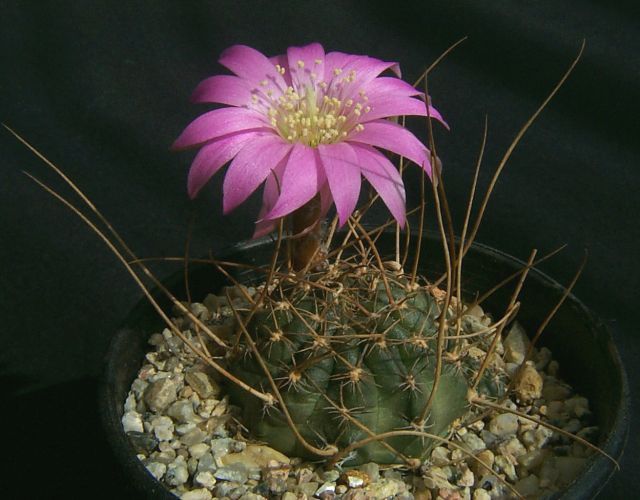|
Echinopsis Bridgesii (Jardin Des Plantes De Paris)
''Lobivia bridgesii'', is a species of '' Lobivia'' found in Bolivia. Description This species often grows in groups and forms three to six shoots from the base. The spherical to elongated shoots reach heights of up to 40 cm with a diameter of 13 cm. There are nine to twelve distinct ribs that are notched or notched. The large areoles on it are brown. From them spring short and conical or longer and needle-like thorns of up to 2 centimeters in length. The mostly single central spine, sometimes it is missing or several are formed, is tipped gray and darker. The 8-10 very uneven marginal spines are brown. The white flowers open at night. They are 15 to 20 centimeters long. Distribution ''Lobivia bridgesii'' is commonly found in the department of La Paz, Bolivia growing in dry valleys and the puna grassland The puna grassland ecoregion, of the montane grasslands and shrublands biome, is found in the central Andes Mountains of South America. It is considered one ... [...More Info...] [...Related Items...] OR: [Wikipedia] [Google] [Baidu] |
Joseph Zu Salm-Reifferscheidt-Dyck
Joseph Franz Maria Anton Hubert Ignatz Fürst und Altgraf zu Salm-Reifferscheidt-Dyck (4 September 1773 at Castle Dyck near Neuss – 21 March 1861 in Nice) was a German amateur botanist and owner of Castle Dyck. Dyck was a member of an important aristocratic family that had ruled a small territory until the mediatisation of small German states in the early 19th century. His wife, Constance de Salm Princess Constance de Salm (7 September 1767 – 13 April 1845) was a French poet and miscellaneous writer. She wrote a series of poetical "Epistles", one "To Women", another "On the Blindness of this Age". She also wrote, ''My Threescore Years'' ( ..., was a poet and miscellaneous writer. Works * ''Monographia generum Aloes et Mesembryanthemi'': ** ''Fasciculus 1'' . Arnz, Düsseldorpii 836Digital editionby the University and State Library Düsseldorf ** ''Fasciculus 2'' . Arnz, Düsseldorpii [1836Digital editionby the University and State Library Düsseldorf ** ''Fasciculus 3 ... [...More Info...] [...Related Items...] OR: [Wikipedia] [Google] [Baidu] |
Lobivia
''Lobivia'' is a genus of Cactus, cacti native species, native to South America from Bolivia, Peru to northwestern Argentina and Northern Chile. Species Species of the genus ''Lobivia'' according to Plants of the World Online : References External links * * {{Authority control Lobivia, Cacti of South America Endemic flora of Argentina Endemic flora of Bolivia Endemic flora of Peru Cactoideae genera ... [...More Info...] [...Related Items...] OR: [Wikipedia] [Google] [Baidu] |
La Paz Department (Bolivia)
The La Paz Department of Bolivia comprises with a 2012 census population of 2,706,359 inhabitants. It is situated at the western border of Bolivia, sharing Lake Titicaca with adjacent Peru. It contains the '' Cordillera Real'', which reaches altitudes of . Northeast of the Cordillera Real are the ''Yungas'', the steep eastern slopes of the Andes Mountains that make the transition to the Amazon River basin to the northeast. The capital of the department is the city of La Paz and is the administrative city and seat of government/national capital of Bolivia. Provinces The Department of La Paz is divided into 20 provinces (''provincias'') which are further subdivided into 85 municipalities (''municipios'') and - on the fourth level - into cantons. The provinces with their capitals are: Government The chief executive office of Bolivia's departments (since May 2010) is the Governor; before then, the office was called the Prefect, and until 2006 the prefect was appointed by ... [...More Info...] [...Related Items...] OR: [Wikipedia] [Google] [Baidu] |
Bolivia
, image_flag = Bandera de Bolivia (Estado).svg , flag_alt = Horizontal tricolor (red, yellow, and green from top to bottom) with the coat of arms of Bolivia in the center , flag_alt2 = 7 × 7 square patchwork with the (top left to bottom right) diagonals forming colored stripes (green, blue, purple, red, orange, yellow, white, green, blue, purple, red, orange, yellow, from top right to bottom left) , other_symbol = , other_symbol_type = Dual flag: , image_coat = Escudo de Bolivia.svg , national_anthem = " National Anthem of Bolivia" , image_map = BOL orthographic.svg , map_width = 220px , alt_map = , image_map2 = , alt_map2 = , map_caption = , capital = La Paz Sucre , largest_city = , official_languages = Spanish , languages_type = Co-official languages , languages ... [...More Info...] [...Related Items...] OR: [Wikipedia] [Google] [Baidu] |
Puna Grassland
The puna grassland ecoregion, of the montane grasslands and shrublands biome, is found in the central Andes Mountains of South America. It is considered one of the eight Natural Regions in Peru,Pulgar Vidal, Javier: Geografía del Perú; Las Ocho Regiones Naturales del Perú. Edit. Universo S.A., Lima 1979. First Edition (his dissertation of 1940): Las ocho regiones naturales del Perú, Boletín del Museo de historia natural „Javier Prado“, n° especial, Lima, 1941, 17, pp. 145-161. but extends south, across Chile, Bolivia, and western northwest Argentina. The term puna encompasses diverse ecosystems of the high Central Andes above 3200–3400 m. Location The puna is found above the treeline at 3200–3500 m elevation, and below the permanent snow line above 4500–5000 m elevation. It extends from central Peru in the north, across the Altiplano plateau of Peru, Chile and Bolivia, and south along the spine of the Andes into northwest Argentina. Other sourc ... [...More Info...] [...Related Items...] OR: [Wikipedia] [Google] [Baidu] |
Echinopsis Comarapana1PCJO
''Echinopsis'' is a large genus of cacti native to South America, sometimes known as hedgehog cactus, sea-urchin cactus or Easter lily cactus. One small species, ''E. chamaecereus'', is known as the peanut cactus. The 128 species range from large and treelike types to small globose cacti. The name derives from ''echinos'' hedgehog or sea urchin, and ''opsis'' appearance, a reference to these plants' dense coverings of spines. They are remarkable for the great size, length of tube, and beauty of their flowers, which, borne upon generally small and dumpy stems, appear much larger and more attractive than would be expected. Taxonomy Studies in the 1970s and 1980s resulted in several formerly separate genera being absorbed into ''Echinopsis'': Some have proposed merging ''Rebutia'' as well. Like several other taxonomic changes in Cactaceae, this one has not been universally accepted. Amateur and professional growers still use names like ''Echinopsis'' (in the older sense), ... [...More Info...] [...Related Items...] OR: [Wikipedia] [Google] [Baidu] |
Echinopsis Bridgesii (Jardin Des Plantes De Paris)
''Lobivia bridgesii'', is a species of '' Lobivia'' found in Bolivia. Description This species often grows in groups and forms three to six shoots from the base. The spherical to elongated shoots reach heights of up to 40 cm with a diameter of 13 cm. There are nine to twelve distinct ribs that are notched or notched. The large areoles on it are brown. From them spring short and conical or longer and needle-like thorns of up to 2 centimeters in length. The mostly single central spine, sometimes it is missing or several are formed, is tipped gray and darker. The 8-10 very uneven marginal spines are brown. The white flowers open at night. They are 15 to 20 centimeters long. Distribution ''Lobivia bridgesii'' is commonly found in the department of La Paz, Bolivia growing in dry valleys and the puna grassland The puna grassland ecoregion, of the montane grasslands and shrublands biome, is found in the central Andes Mountains of South America. It is considered one ... [...More Info...] [...Related Items...] OR: [Wikipedia] [Google] [Baidu] |
Lobivia
''Lobivia'' is a genus of cacti native to South America from Bolivia, Peru to northwestern Argentina and Northern Chile. Species Species of the genus ''Lobivia'' according to Plants of the World Online Plants of the World Online (POWO) is an online database published by the Royal Botanic Gardens, Kew. It was launched in March 2017 with the ultimate aim being "to enable users to access information on all the world's known seed-bearing plants by ... : References External links * * {{Authority control Cacti of South America Endemic flora of Argentina Endemic flora of Bolivia Endemic flora of Peru Cactoideae genera ... [...More Info...] [...Related Items...] OR: [Wikipedia] [Google] [Baidu] |



.jpg)
